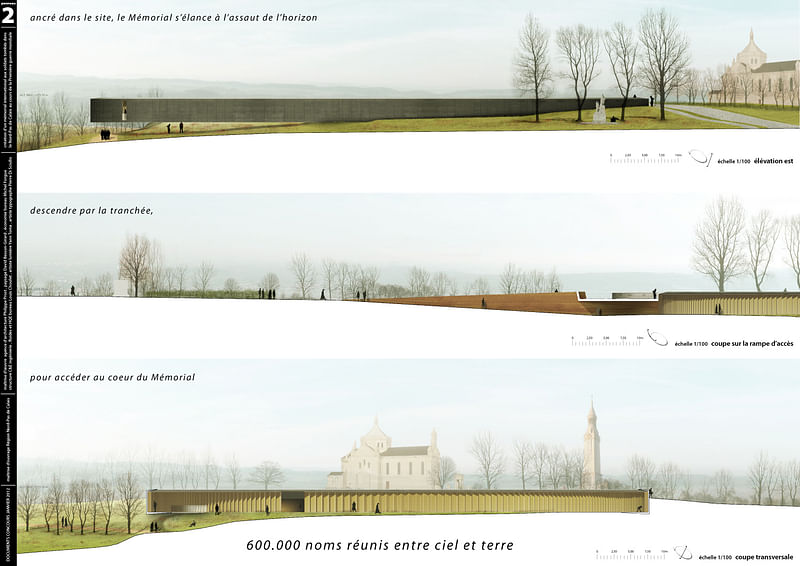World War I International Memorial at Notre-Dame-de-Lorette to be inaugurated in November
By Bustler Editors|
Tuesday, Sep 16, 2014

Related
Upon the centenary commemoration of the tragic events that occurred in the Nord-Pas-de-Calais region during the Great War, the International Memorial at Notre-Dame-de-Lorette in France will be officially inaugurated on November 11, 2014.
Designed by architect Philippe Prost -- who had the winning proposal in a competition against five French and international teams -- the large ring of the memorial is etched with all 580,000 names of the soldiers who died in the French Flanders and in the Artois region between 1914 and 1918.
Mémorial international à Notre-Dame-de-Lorette. AAPP from Philippe Prost/AAPP on Vimeo.
Scroll down to learn more about the project and its historic site.
Project description:
"In the framework of an agreement signed with the French State (Ministry of Defence) in 2011, the Nord-Pas-de-Calais Regional Council initiated a major programme in the framework of the Centenary Commemorations of the Great War: the establishment of an international memorial paying respect to fighters of all nationalities who perished in this land between 1914 and 1918, friends and foes of yesteryear together, listed simply in alphabetical order.
This is a truly unique initiative as it falls outside the scope of the national framework which was at the core of the conflict in the 20th Century. It falls within a more general reflection which does not celebrate the claimed victory of some or stigmatise those who were defeated. Instead, it focuses on the shared suffering, that was experienced by all soldiers, the mass death which characterised the wars of the industrial era and which, between 1914 and 1918, struck down a generation of young men, as well as the grief which affected millions of families. The International Memorial at Notre-Dame-de-Lorette will also allow it to be underlined that peace has reigned for the first time, in a sustainable manner, on the European continent."

"The Memorial at Notre-Dame-de-Lorette Plateau is an exceptional work in many aspects:
- It is, first of all, unique in today’s world to bring together men in a single memorial and to pay a single homage to those who clashed in a terrible, bloody conflict.
- The list of 580 000 names of soldiers appears in alphabetical order, regardless of nationality, rank or religion.
- A real monument, with wonderful aesthetic and symbolic value, at a time when an increasing amount of immaterial forms of memorials are appearing with the constitution of databases (to be located in a public museum set to be inaugurated at the same time as the Memorial at the foot of the Notre-Dame-de-Lorette hill)
- a major tourist site and meeting point for the “ Memorial trails “ of the Great War, accessible by the general public who are lucky enough to live in times of peace. "

"The Memorial is erected on a plot spanning 2.2 hectares, granted by the State to the Regional Council in the Nord-Pas de Calais for a token amount. The inclusion of the Memorial in a 'sacred perimeter', that of the Notre-Dame-de-Lorette national necropolis (a listed site pursuant to the 1930 Act) imposed some major aesthetic and architectural requirements during the competition during appointment of the contracting party: Respecting the French national necropolis located nearby, the need to retain the vision of the large landscape overlooking Artois, the obligation to design a striking work with a universal scope.
The [winning] project by Parisian architect Philippe Prost [is] sober and impressive, respectful and powerful, which perfectly meets the requirements set out by the project manager. A large ellipse is placed on the slope of the plateau; One third of the circumference is installed off-centre in order to symbolise the fragile nature of peace. You can enter into the memorial through a trench which then gives access to a footbridge along which plaques are installed each bearing the names of soldiers like the pages of a book. The structure, in steel fibre, is held by a suspended cable. The ring, a simple and striking symbol, symbolises a circle; this is synonymous of unity and eternity."

"Notre-Dame-de-Lorette, a major site of the Great War: Notre-Dame-de-Lorette hill, located a dozen kilometres to the north of Arras, was the stage in 1914 and 1915, of bloody combat between the French and German armies...On 16 January 1924, a decree by the President of the French Republic decided on the creation of a national necropolis on the summit of the “bloody plateau“ at Notre-Dame-de-Lorette. With a total surface area of 27 hectares, it houses some 40,000 bodies of French soldiers killed in Flanders and Artois during the Great War.
The cemetery was constituted from a small temporary cemetery, developed in 1915 close to the ruins of an 18th Century chapel, destroyed during the fighting. During the 1920s, bodies from across the 150 temporary cemeteries between the Somme and the North Sea were collected and buried here. 19,998 unidentified bodies were buried in seven graves; the remains of 20,000 identified bodies were buried individually; a special grave was constructed to bury the bodies of Muslim and Jewish soldiers."

"Neglected for a long time, the Notre-Dame-de-Lorette site has undergone redevelopment thanks to a joint programme led by the State and the Local authorities (Pas-de-Calais Department and the Lens-Liévin Conglomeration) in the framework of the Centenary celebrations.
Notre-Dame-de-Lorette is at the very centre of a collection of memorial locations...There are indeed, within a radius of 10km, three major sites of interest: The Canadian National Memorial at Vimy erected between the First and Second World Wars; The German cemetery at Maison-Blanche, in Neuville-Saint-Vaast; And finally, the British cemetery at Cabaret Rouge, in Souchez."

Share
0 Comments
Comment as :